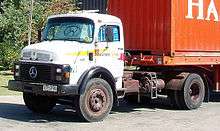Mercedes-Benz short-bonnet trucks
The Mercedes-Benz "Kurzhauber" (short-bonnet) truck is a conventional layout, cab-after-engine truck manufactured from 1959 to 1995. In Germany it is most commonly referred to as the Kurzhauber (for "short bonnet").[1] The engine intruded into the cabin underneath the windshield, all in the name of making a shorter truck to meet the strict period German regulations on overall length. The L-series was built in many countries and remains in service throughout many of the regions to which it was exported.

History
The L-series was first produced in Germany in 1959 and was in production for export until 1995, long after domestic German sales had ended.[1] The L-series was a big export success for Mercedes-Benz and became very popular in the Middle-East, South America and Africa. In Arabia, the L-series in 6x6 sleeper cab configuration (Model 'LS') handled heavy road traction almost exclusively.
Originally, medium-weight trucks (L323 and L327, with 110 PS or 81 kW inline-six diesels) intended for shorter delivery and construction work were built in Mercedes' Mannheim plant. The heavier trucks, for long-distance and heavy construction work, were built in the Gaggenau plant.[2] These were designated L337 and L332B (L334B from 1960), with 12 t (26,500 lb) or 19 t (41,900 lb) total weights and 172–180 PS (127–132 kW) diesel six-cylinders. In 1962 the more powerful 19 tonne L334C was added, mainly intended for export. The model designations were a warren of letter combinations reflecting the vehicle's intended use, until a new system (still in use today) including overall weight and engine power was introduced in the summer of 1963.[2]
The 5.7 L (5,675 cc) OM352 was Mercedes-Benz' first direct-injection diesel engine. After having debuted in 1964, a 130 PS (96 kW) it found its way into the Kurzhauber in the 1967 L/LP 1113B series ("11" for the tonnage, "13" reflecting tens of horsepower). The engine (and other versions thereof) gradually spread through the range, replacing the earlier indirect-injection units.[3]
Just as the Dodge Power Wagon became synonymous with oil exploration throughout Arabia in the 1950s, the L-series, together with the Kenworth 953 became the two trucks which were synonymous with the oil exploration boom in Arabia throughout the 1960s. Many roads throughout Arabia were not surfaced until the early Eighties and there were no weight or length limitations on road haulage. This meant that the trucks carried heavier loads than for which they were designed, in some instances three times the maximum designed loaded weight, and in carrying these loads, the L-series gained a reputation for toughness and reliability. Nearly all L-series shipped to Arabia were orange in color, while all L-series shipped to North Africa were green in color.
Continuation
After 1995 production in Germany ceased but was continued at Mercedes-Benz factories in South America, where it had already been built for decades. The trucks built in Brazil received a facelift in 1982, with a squared off grille in black plastic featuring rectangular headlights for a more modern (albeit somewhat incongruous) look.[3] Brazilian-built Mercedes-Benz L-series trucks were assembled CKD by Freightliner until the end of 1990, the result of Daimler-Benz' 1981 purchase of the Oregon-based manufacturer.[4] The Brazilian Kurzhaubers were sold as Class 6/7 trucks in the United States until 1991, when a Freightliner-badged replacement took over. Mercedes-Benz never made any substantial inroads into the US market, with a 1.5 percent market penetration in the segment in 1989 (2,037 trucks sold).[4]
In Argentina, the L-Series made until 1997, when ceased in favour of the Sprinter and bus chassis only. The models made in the Virrey del Pino plant are: L 311, L 312, L/LS 1112, LA 1112, L 914, LA/LAS 1114, L/LK/LS 1114, L/LK 1215, L/LK 1218, L/LK 1514, L/LS/LK 1517, L/LS 1521, LA 1419, L/LS/LK 1518, L/LS 1526, L/LK 1615, L 1619, L 1620, L/LS 1622, L/LS 1633. In this country, the most popular versions of this line were the Mercedes 1114, which were known by the expression "once-catorce" ("eleven-fourteen" in English). Currently in Argentina, only the Atron 1735 are the only short bonnet made since 2016.
In Iran it is known as Benz Meiller and it still produced by Iran Khodro Diesel Company as Khawar (lit. East).[5] in 2 models : 2624 & 1924. The former model 2628 stopped being produced.
Footnotes
- "Lastwagen und das Wirtschaftswunder: Kurzhauber lösen die Haubenwagen aus der Nachkriegszeit ab" [Trucks and the economic miracle: The Kurzhauber replaces the post-war bonneted trucks]. Classic (in German). Mercedes-Benz. Retrieved 2012-05-16.
- "Mercedes-Benz" (in German). www.lkw-infos.eu. Archived from the original on 2012-04-21. Retrieved 2012-05-16.
- "Mercedes-Benz: L / LA / LK / LF / LS middle range". TrucksPlanet. Retrieved 2012-05-16.
- Duncan, Thomas W. (July 1990). "Freightliner nameplate chosen for new medium-duty trucks". Fleet Owner. Vol. 85 no. 7. FM Business Publications. p. 18.
- "Archived copy". Archived from the original on 2014-03-10. Retrieved 2014-03-15.CS1 maint: archived copy as title (link)
External links
| Wikimedia Commons has media related to Mercedes-Benz LA. |
| Wikimedia Commons has media related to Mercedes-Benz LS. |